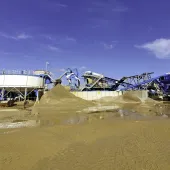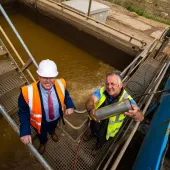Water Monitoring Methods and Systems

First published in the July 2013 issue of Quarry Management as Water Monitoring
Environmental data collection: Protecting yourself
By James Dodds and Lee Clarke, Envireau Water
With regulators taking a harder approach to breaches of consents and permits; the need for abstraction licences for dewatering getting ever nearer; and planning conditions seemingly getting tighter; the need for monitoring data gets ever greater. The cost of installing and managing monitoring systems is significant, with even single-point systems costing several thousand pounds to set up, let alone the time spent on managing data. It is critical, therefore, that as much value as possible is obtained from the data.
Within the quarrying industry there are essentially three basic types of natural water-related monitoring that are carried out:
- Quarry discharges (flow and composition)
- Natural surface water flow, chemistry and ecology
- Groundwater level.
Each of the above requires a different approach in terms of technology, but each also has the same key issues that need to be considered when designing and specifying a scheme or method.
- Why are you monitoring?
- Field installation
- Survey
- Data collection frequency.
Why are you monitoring?
This is a critical issue. The purpose of the monitoring and the users of the data will define how the scheme is implemented. For example, if a discharge is being monitored for compliance purposes, should the installation be MCerts accredited? Collection of the minimum amount of data will show whether the discharge is compliant or not, but may not provide any added value. Collecting data at the same location in a different way may provide essentially free added value, by being able to analyse the data scientifically. For instance, obtaining continuous flow measurement as opposed to cumulative spot measurements would provide data on the drainage characteristics of the quarry catchment which would provide essential data in a flood-risk assessment for an extension. Alternatively, the same data would allow settlement or attenuation pond performance to be reviewed; to be sized appropriately; and to aid maintenance schedules to further reduce the risk of noncompliance.
If the purpose of the monitoring is fundamentally scientific, eg to support a Hydrogeological Impact Assessment, the scheme must consider the value of the data obtained. Spending money on collecting poor or inappropriate data is obviously a waste. To maximize the value, the scheme should consider the following:
- Appropriate monitoring
- Baseline conditions
- Ease of post-processing
- Appropriate analysis of data.
Field installation
The first question to consider when thinking about the installation is whether it is temporary or permanent. Closely linked to this is how long the equipment will be installed for. Obviously, a short test period of a week or so is definitely temporary; but can the same be said of a year’s worth of baseline monitoring? The longevity of the installation will determine the effort put into setting up the equipment and the choice of equipment. Generally, the more temporary the installation, the lower the accuracy of the data collection, simply because it is seldom worth the effort and cost of installing systems to a high standard. It is not uncommon for a temporary installation to morph into a permanent installation, resulting in lower-quality data than is appropriate being collected over a long period of time. Equally, if effort and cost are going to go into the installation of equipment, it should last as long as is reasonable to give the greatest financial return.
What are we monitoring? White it may seem an obvious question, it is surprising how often it is either ignored or not thought about. For instance, if river flow is being measured, is the interest in flood flows, low flows or peak flows; is a full hydrograph required or simply spot data; is river stage (water level) important, or just flow? When considering groundwater levels, are we sure which geological horizon is being monitored and does it matter? Do we need to monitor discharge flow rate and suspended solids in unison or are total volumes of discharge and spot quality measurements only required, and where in the system would the best location be?
Figure 1a shows a hydrogeological situation which illustrates the importance of understanding what is being monitored. Borehole A was interpreted as measuring a ‘perched aquifer’. The graph (fig. 1b), which plots the screen elevation against the water level elevation, shows that the groundwater system is a continuum and that the whole system is ‘unconfined’. While being quite technical, this level of understanding is important in order to obtain the correct conceptual understanding of a situation and, therefore, to predict dewatering impacts, mitigation options etc. Knowing what the outcomes may be, and how the technical data will be interpreted, is important when designing and installing the monitoring system.
If MCerts is a requirement of the monitoring (with most quarry monitoring it is not a requirement but might be advised), specific equipment and installation will be required, which could affect the location due to space and power requirements. If the cost of an MCerts installation is going to be borne, consideration should be given to maximizing the data value by appropriate measurement, data storage, management and reporting.
Survey
Finally, after the time, money and effort that goes into installing the system, there must be an accurate record of the installation details. This must include not only details of the equipment, but also the position of sensors relative to a fixed datum, which itself should be surveyed relative or ordnance datum. A record of upstream and downstream pipe diameters, flares, valves and bends is vital. Channel dimensions or weir details must be noted. Calibration data such as water depth, level or quality should be collected and recorded. Such data allows any inconsistent or unexpected data collected from the system to be reviewed and analysed in the context of the as-built field installation.
Data-collection frequency
In the past the only option for data collection was by means of a person taking a measurement and recording it in a notebook. This method has major advantages in that each site is visited, allowing it to be inspected and checked with any physical changes noted and taken into account in the data interpretation. However, it also has major disadvantages, mainly cost and the fact that data can only be collected as frequently as weekly, and more likely monthly, over any significant period of time.
Figure 2 shows a river flow data set with high-frequency monitoring, superimposed with monthly monitoring. The figure shows that long-frequency data monitoring misses key events and would lead to completely erroneous conclusions. In this case the monthly data would be worse than useless.
The fact that logging equipment can record at very short intervals does not mean that a short interval is appropriate. An inappropriate short interval will result in very large data files and either time being wasted on post-processing, or worse still, the data not being reviewed because it becomes too big a job. Therefore, thought must be given to the optimal interval. Consideration should be given to:
- Regulatory requirements
- Frequency/wavelength of the data variation
- The level of detail needed for the data analysis.
For example, for background groundwater level monitoring, daily data will normally suffice; if the instrumentation will allow, a period when daily maxima and minima are recorded will allow response to rapid recharge of river flows to be evaluated. When analysing stream flows for run-off characteristics and storm events, 15min intervals will be required. If the interest is in base flow analysis, hourly data would suffice.
As the data record extends over a period of years, the recording interval can be increased. At any point, recording intervals can be reduced for a period of time, to study an aspect of the data response in more detail.
In essence, the less time available to draw conclusions, the higher the resolution and the shorter the monitoring interval that will be required.
With or without telemetry?
Electronic data-logging has been around for a long time and systems are simple, accurate, relatively cheap and reliable. The next stage in development is telemetry, ie ‘beaming’ the data back to the office without the need to go out to site to collect the data from the logger. While telemetry systems have also been around for a long time and are frequently used within the mobile plant environment at mines and quarries, their use in the field of environmental monitoring is less common.
Telemetry offers some major advantages over manually downloaded data collection. The access to live or nearly live data means that problems with equipment, data quality or regulatory compliance can be spotted almost immediately. Many telemetry systems will ‘self-report’ an equipment or compliance problem using a text message or email. Monitoring of specific natural events such as floods or recharge, unnatural events such as blasts (and its effects on water levels) and water-quality impacts due to site activities can be viewed in ‘real time’, allowing instant analysis and interpretation. Two-way communication with monitoring stations allows monitoring intervals to be re-set to allow detailed data collection and recording to take place for a short time, to examine a specific issue. The ability to do all this means that data becomes more focused and the cost of people attending the equipment reduces as they only need to go out when required, as opposed to routinely.
However, telemetry also has its disadvantages. Cost is certainly one, as is power supply. A telemetry outstation requires more power than a simple measurement and logging device. The performance of long-life sealed and rechargeable batteries is improving all the time, but if frequent data transfer is required then power from the mains or solar/wind recharging will be required. This poses an added security problem as the monitoring station becomes very visible and open to theft or vandalism, or both.
It can be difficult to decide whether telemetry is required, and cost is a big factor. But this must be balanced by the cost of losing or not having the right data at the right time to make the right decision.
Summary
Environmental data collection is an increasingly important part of quarrying life. Long gone are the days when a monitoring system could be a pile of dusty papers in the corner of a back office with pencil scribbles on them. Today there is too much risk, both financial and reputational, in finding out too late that there has been a breach of a condition or regulation. Modern measurement, data-logging and telemetry systems allow data to be collected, recorded and distributed efficiently. The flexibility in the systems available means that any site can develop an appropriate scheme and method of monitoring, with an associated management plan that protects both the business and the environment.
For further information contact James Dodds on tel: (01332) 871882; email: james@envireauwater.co.uk
- Subscribe to Quarry Management, the monthly journal for the mineral products industry, to see articles before they appear on Agg-Net








